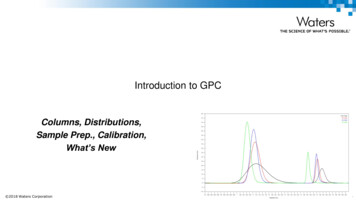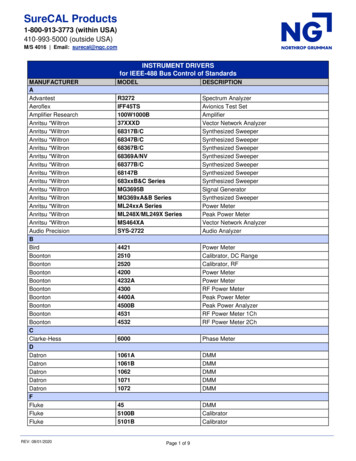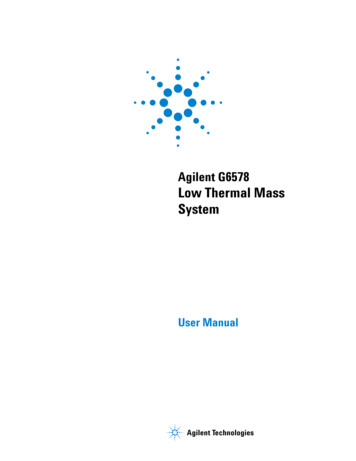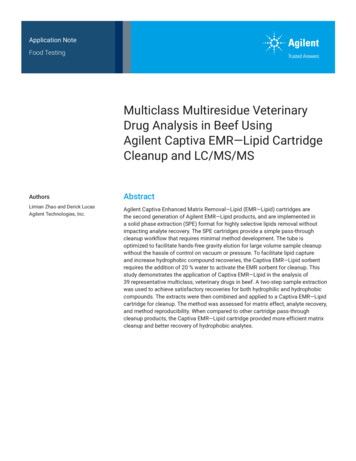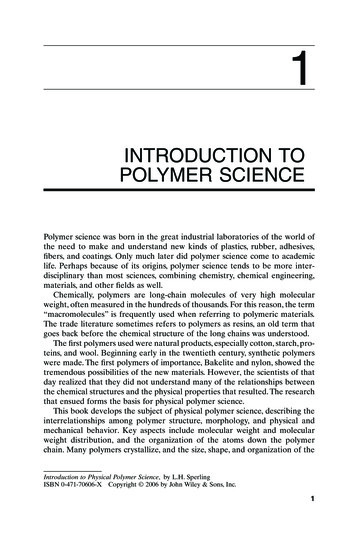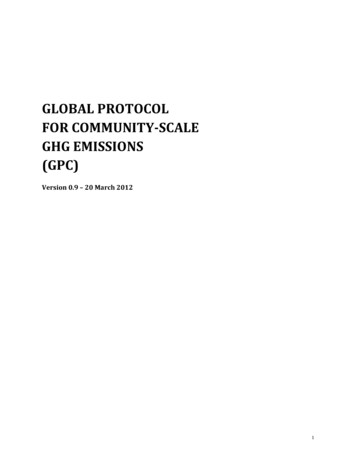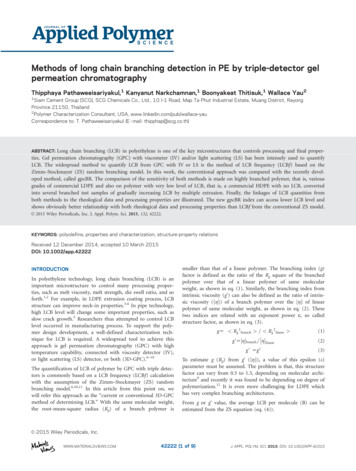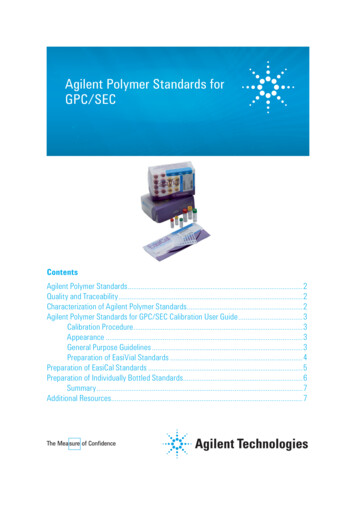
Transcription
Agilent Polymer Standards forGPC/SECContentsAgilent Polymer Standards.2Quality and Traceability.2Characterization of Agilent Polymer Standards.2Agilent Polymer Standards for GPC/SEC Calibration User Guide.3Calibration Procedure.3Appearance.3General Purpose Guidelines.3Preparation of EasiVial Standards.4Preparation of EasiCal Standards.5Preparation of Individually Bottled Standards.6Summary.7Additional Resources.7
Agilent Polymer StandardsPolymer standards from Agilent are produced in a specialized manner to impart specific characteristicsnot found in mass-produced counterparts. The use of stringent synthesis conditions and purified reagentsresults in polymers of the highest purity and the narrowest molecular weight distribution available. This isan important consideration when selecting polymer reference standards.Agilent has 40 years of experience in the synthesis and characterization of polymers, employing a widevariety of proprietary techniques. With such extensive characterization, Agilent polymer standards areideal reference materials for use in analytical techniques that require calibration methods or routine checksof performance.The polymers selected for the kits have been chosen to complement Agilent GPC/SEC columns, and toproduce the equidistant calibration plot necessary for accurate polymer analysis by GPC/SEC.Quality and TraceabilityThe Agilent philosophy is based on producing the most reliable, extensively characterized polymerstandards available worldwide, and on ensuring continuity of supply and reproducibility of replacementbatches.Polymer standards manufactured by Agilent are Reference Materials characterized according to themethods detailed by our ISO 9001:2008 certified quality system. Each polymer standard is assigned aunique batch number and supplied with a Certificate of Analysis that details the exact methods used andthe characterization results assigned.Agilent is totally committed to the quality, reliability, and absolute accuracy of their range of polymerstandards, giving the customer security in the knowledge that they have purchased the best referencematerials worldwide.Characterization of Agilent Polymer StandardsPolymers consist of a distribution of many molecular species. The average molar masses (M) reportedresults from several possible methods of averaging the different species present. Agilent polymerstandards are characterized by various well-defined methods: Light Scattering to determine Mw Viscometry to determine Intrinsic Viscosity High-resolution Gel Permeation Chromatography (GPC) to determine Mn, Mw, Mw/ Mn and Mp.2
Agilent Polymer Standards for a GPC/SEC Calibration User GuideCalibration ProcedureBoth conventional GPC/SEC using a single concentration detector, and GPC/SEC viscometry usingUniversal Calibration rely on an initial calibration.Old calibration curves produce increasingly inaccurate data with time. Calibration at the start and end of asample set is best practice. At minimum, systems should be calibrated at startup, and weekly thereafter.When constructing a GPC/SEC calibration plot, the Mp value for the standard should be used. Operatingconditions for different analytical techniques vary according to the type of polymer and the molecularweight. Full details of the analysis conditions are described on the Certificate of Analysis, together with theexpiry date.AppearanceIndividual polymer standards: White powder, waxy lumps, or viscous liquid according to Mw andcomposition, see Note below.Agilent EasiCal: Two sets of PTFE spatulas, differentiated by the presence of a small hole, withthe polymer mixture deposited on the small end.Agilent EasiVial: Three sets of color-coded glass vials with a polymer film deposited on the inner surface.Polystyrene and PMMA EasiVials are supplied in clear vials. PEG and PEG/PEO EasiVials are supplied inamber vials.Note: Very low molecular weight polymers are liquid or semisolid at room temperature. Similarly, many lowmolecular weight standards will soften or liquefy if exposed to mild heat. Liquid standards are most easilyhandled by glass pipette. Softer polymer standards that have aggregated may be refrigerated until solid,carefully cut with clean shears, and handled as chips.General Preparation GuidelinesThe use of freshly prepared polymer standards is recommended. Standards should be dissolved in thesame batch of mobile phase being run in the columns. Please allow at least 3 hours for molecular weightstandards 500,000 g/mol to fully dissolve. If an internal flow rate standard is being used, it needs tobe monodisperse, eluted after the separation limit, and only added to the polymer standard solution. Ananalytically pure small molecule is generally recommended.High molecular weight polymers ( 500,000 g/mol) are also more likely to suffer from mechanical orthermal degradation during sample preparation. These polymer standards should be allowed to swelland dissolve slowly, for at least 24 hours, with only gentle stirring. The exact system conditions ofconcentration, injection loop size, and so forth, will vary per system setup.3
Preparation of Agilent EasiVial StandardsPrepare EasiVial standards by adding solvent to one of each color-coded containers. The concentrationof the standards will depend on the dn/dc for the solvent system in use, and the relative sensitivity of thedetectors.Table 1. Recommended solvent volumes.Solvent system2 mL Vials4 mL VialsPolystyrene in THF (dn/dc 0.185 mL/g)1 mL2 mLPolystyrene in TCB (dn/dc 0.053 mL/g)0.5 mL1 mLPMMA in THF (dn/dc 0.085 mL/g)1 mL2 mLPEG/PEO in water (dn/dc 0.136 mL/g)1 mL2 mLABFigure 1. Typical PS-M EasiVial chromatograms and calibration plot.4
Preparation of Agilent EasiCal StandardsPrepare EasiCal standards by filling two vials with solvent, removing one of each type of spatula from thepackage, and stirring one spatula into either vial.Figure 2. Preparation of EasiCal standards.Spatula A5Retention time30Retention time30Spatula B5LogMW7313Retention time25Figure 3. Typical PS-1 EasiCal chromatograms and calibration plot.5
Preparation of Individually Bottled StandardsWeigh out individual standards, and dissolve them in the eluent according to the recommendedconcentrations below. For accurate results, follow instructions given in the previous General PreparationGuidelines section.Table 2. Recommended concentrations.Peak molecular weight (Mp g/mol) Concentration (mg/mL) 5,000 1.05,000–25,000 0.525,000–400,000 0.25400,000–2,000,000 0.20 2,000,000 0.05Table 3. Example of mg/mL or a 0.1 % wt/vol solution.Mass (g) Volume (mL)0.0011.00.0110The size of the injection loop also determines the quantity of polymer being injected onto the column. Referto the GPC/SEC columns user guide (publication number 5991-3792EN) for recommended values.Low molecular weight standards resolve with multiple oligomeric peaks. The highest peak is used for theMp of the standard.Polystyrene MW 1,270Polystyrene MW 5800Retention timeFigure 4. Typical chromatograms of low molecular weight standards showing oligomeric detail.620
Summary Calibration curves lose accuracy over time, causing error. Calibrate before and after critical samplesets. For standard work, calibration at startup and weekly thereafter is adequate. Verify that the molecular weight range of the polymer standards covers the complete resolving range ofthe columns listed in the selection guide. Accurately prepare fresh solutions as per Table 1, and allow the correct length of time, given themolecular weight, for complete dissolution. It is possible to generate a custom mixture of individual standards, provided they do not coelute. Themolecular weights should vary by an order of magnitude, for example, for polystyrene: 1 kDa, 10 kDa,and 100 kDa. The convenient EasiVial and EasiCal ranges have been specially selected to avoidcoelution. Take care to avoid overloading the column. Use Table 2 as a guide to select concentrations, minimizingthe sample load on-column where possible. Construct your GPC/SEC calibration using the Mp values stated on the certificates.StorageMost standards should be stored under normal conditions (at room temperature, in a drawer or cupboard)and do not require special storage conditions. Once prepared, dilute polymer solutions are prone todegradation, and it is recommended that they are stored in a cool, dark environment for no longer than7 days.Polyethylene oxide standards react slowly with oxygen to form peroxides along the backbone in a processthat is facilitated by light. These peroxides can lead to chain cleavage. Therefore, we recommend thatpolyethylene oxides are stored refrigerated under an inert gas (argon or nitrogen).Additional Resources GPC/SEC Standards Product Guide - Publication number 5990-7996EN Calibrating GPC Columns: A Guide to Best Practice - Publication number 5991-2720EN GPC/SEC Column User Guide - Publication number 5991-3792EN Polymer-to-Solvent Reference Table for GPC/SEC - Publication number 5991-6802EN Step-by-Step Method Development for GPC/SEC - Publication number 5991-7272EN A Guide to Multidetector Gel Permeation Chromatography - Publication number 5990-7196ENTechnical support can also be obtained by contacting us at:http://www.agilent.com/en-us/contact-us/page7
Learn gpc-sec-standardsBuy onlinewww.agilent.com/chem/storeFind an Agilent office or authorized distributorwww.agilent.com/chem/contactusUSA and Canada1-800-227-9770agilent inquiries@agilent.comEuropeinfo agilent@agilent.comAsia Pacificinquiry lsca@agilent.comIndiaindia lsca marketing@agilent.comThis information is subject to change without notice. Agilent Technologies, Inc. 2017Printed in the USA March 28, 20175991-7911EN
handled by glass pipette. Softer polymer standards that have aggregated may be refrigerated until solid, carefully cut with clean shears, and handled as chips. General Preparation Guidelines The use of freshly prepared polymer standards is recommended. Standards should be dissolved in the same batch of mobile phase being run in the columns.
